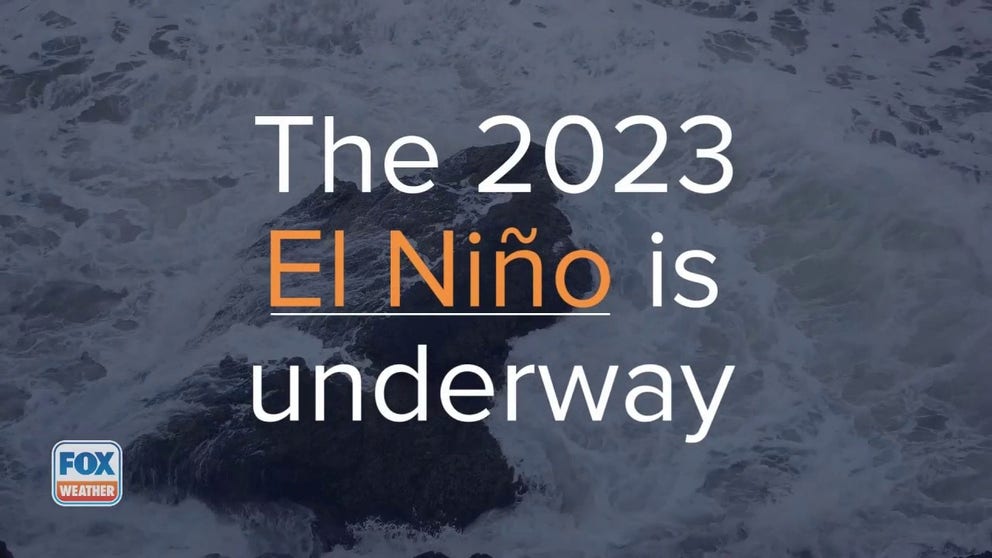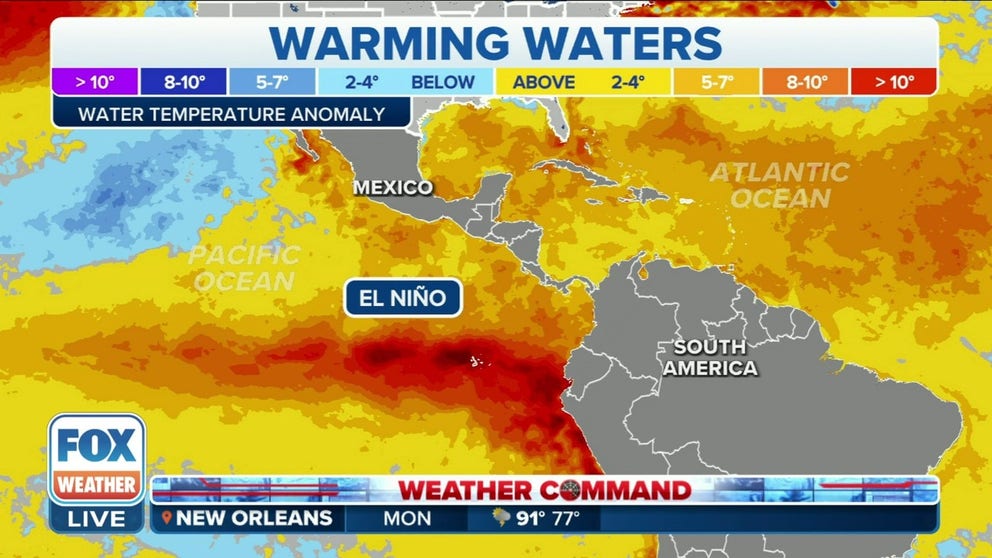Unusually hot Florida sea surface temperatures on track to cause mass coral bleaching event
El Niño years are historically tied to large-scale coral bleaching events but biologists say the Earth has warmed up enough that climate systems have gone awry, causing major bleaching events without an El Niño.
What is an El Nino weather pattern
El Ninos are known to produce extreme weather around the globe. The world entered an El Nino in June 2023, and events are known to produce both good and bad impacts.
Sea surface temperatures around Florida have been higher than 95 degrees early this summer, and biologists said that without some relief, the rising temperatures could lead to a mass coral bleaching event.
Known for its year-round heat, warm water in Florida may not seem unusual to most, but NOAA and coral biologists warn it’s how early the sea surface temperatures hit peak-summer levels that is cause for concern.
NOAA’s Coral Reef Watch coordinator Derek Manzello said the agency has been closely watching sea surface temperatures since March and April because of an El Niño that was developing. Warm water during El Niño years is historically tied to large coral bleaching events.
Manzello said Monday that NOAA recorded the highest sea surface temperature value for the Florida Keys since satellite records began in 1985.
NOAA buoy measurements show water temperatures are near or above 90 degrees around the southern Florida Peninsula.
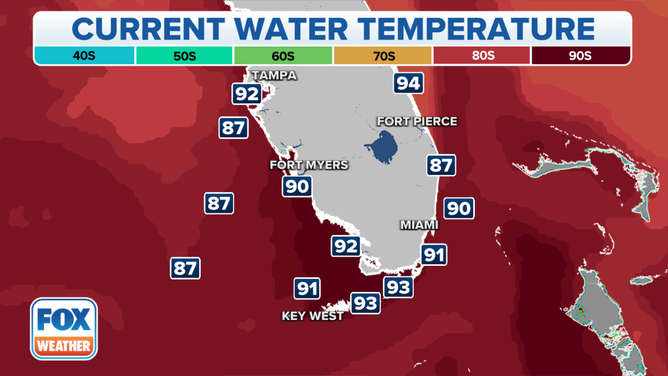
Sea surface temperatures around South Florida on Tuesday, July 11, 2023.
(FOX Weather)
During previous large-scale bleaching events in the Florida Keys in 2014 and 2015, bleaching-level sea surface temperatures did not happen until mid-August.
NOAA FORECAST CALLS FOR HALF OF WORLD’S OCEANS TO EXPERIENCE HEAT WAVE CONDITIONS THIS YEAR
"We are a full month ahead of what is the normal 'bleaching season,’" Manzello said.
The NOAA graph below shows 2023 sea surface temperatures in black, with the recent unprecedented spike in June.

Coral bleaching alert levels for 2023 in comparison to past years.
(NOAA)
NOAA’s Coral Reef Watch predicted early coral bleaching in the Pacific, and those forecasts have come true. Bleaching has been confirmed off the Pacific coasts of Mexico, El Salvador, Costa Rica and Columbia. More recent reports of coral bleaching have been coming in from the Caribbean, off both Mexican coasts and Belize.
Unless a cooling event happens, such as a hurricane or tropical storm that stirs up cold water, the corals of the Florida Keys will have up to three months of temperature-stress conditions.
Manzello said this sustained heat would be unprecedented because most large-scale bleaching events lasted between 4 and 6 weeks.
The ‘Achilles heel of corals’: How coral bleaching starts
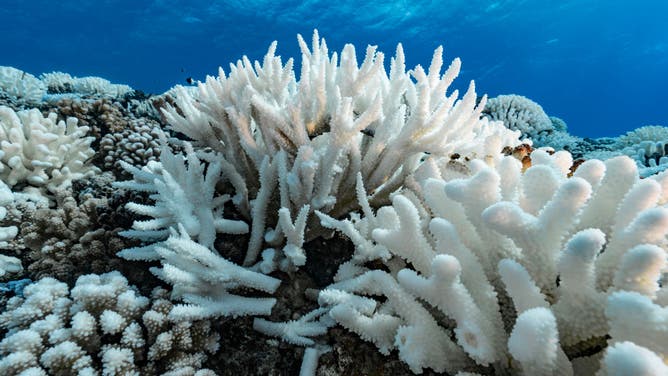
2019 File photo: A view of major bleaching on the coral reefs of the Society Islands on May 9, 2019 in Moorea, French Polynesia. (Photo by Alexis Rosenfeld/Getty Images).
(Getty Images)
Coral biologist Andrew Baker with the University of Miami’s Coral Reef Futures Lab said normally, in July, Florida sea surface temperatures could be about 88-89 degrees. Buoys near the Florida Keys have recently taken measurements of 95 degrees and warmer.
Depending on the type of coral, 2-3 degrees is all it takes for heat stress to begin to take its toll on corals. Coral are living animals that rely on single-celled algae, which produce food for coral through photosynthesis. The algae is also how coral gets color.
"They’re tremendously powerful little buddies, but unfortunately, these algae are also kind of the Achilles heel of corals," Baker said.
When temperatures get too hot, instead of producing photosynthesis, the algae start to produce toxins that produce free radicals. Coral biologists call this oxidative stress, which turns algae "helpers" into killers.
In Florida, thermal stress on coral begins when sea surface temperatures reach 88-89 degrees, according to Baker.
Water temperatures off the coast of Florida approach 100 degrees
NOAA research scientist Dillon Amaya, research scientist with NOAA’s Physical Sciences Lab, joined FOX Weather on Monday morning to break down what could be behind the scorching hot sea temperatures off the coast of Florida.
"The process of coral bleaching is itself quite destructive, and corals have to sort of split open these cells, get rid of the algae symbiotic, release them through their mouths and long streams of mucus, and it's a pretty stressful process, but it's really the coral trying to get rid of the algae so much as quickly as possible because they're producing toxins instead of food," Baker said.
Simply put, coral bleaching occurs because the corals are starving to death after losing their main source of nutrition.
Baker said there are early indicator coral species that begin bleaching before others, and those are starting the bleach in Florida.
"There's a lot of scope for this warming event to build up and continue, and that's really the recipe for doom for corals," Baker said. "It's not just how warm it is, but it's how long it's sustained for, and so the longer that this goes on for, the worse it gets."
The next month will be critical for corals as biologists warn a mass bleaching event is eminent if sea surface temperatures around Florida continue to stay above 90 degrees. Florida’s warmest temperatures usually don’t happen until late July or August.
"If temperatures in Florida were to remain as extreme as they are at right now, we expect that significant mortality of corals in Florida may start occurring over the next several weeks," Manzello said. "However, no one can predict the future, so I very much hope that things cool off and do so rapidly."
Warming oceans require renewed efforts to save coral reefs
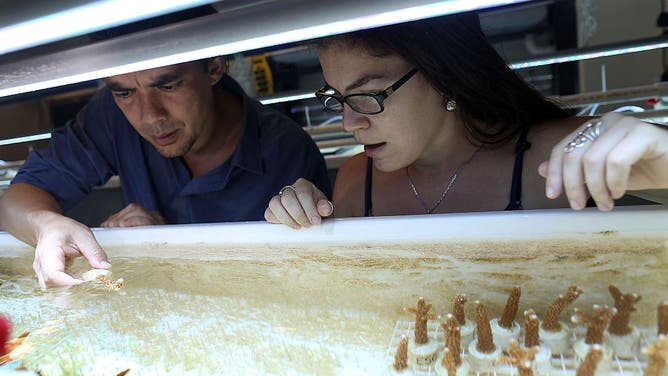
File photo: Andrew Baker (L), Associate Professor, Department of Marine Biology and Ecology, and Rivah Winter, Ph.D. candidate, work on studying staghorn coral in a lab as they take part in researching how multiple climate stressors will impact coral reef in the future at the University of Miami Rosenstiel School of Marine and Atmospheric Science on April 22, 2016 in Miami, Florida. (Photo by Joe Raedle/Getty Images)
(Getty Images)
As the oceans warm, coral biologists warn that bleaching events will get worse. According to NOAA, every coral reef region in the world has been affected by warming waters.
There is a variety of diverse ocean life that live in the coral reefs, including fish and lobster, which boost Florida's fishing economy.
"I think there's a lot that remains to be done in terms of building the climate resilience of Florida's corals, and perhaps this event will just help galvanize those efforts," Baker said.
While the 1982 El Niño event "put coral bleaching on the map," over the last five years, the Earth has warmed enough that an El Niño no longer needs to be happening for a mass coral bleaching event, according to Baker.
There are efforts to restore reefs and also make them more adaptable to warmer waters.
The Mission Iconic Reef program is growing corals to outplant them to seven reefs in the Florida Keys.
Biologists are attempting to preserve coral species by taking polyps to inland facilities. Because coral grows in colonies, it only takes a few small pieces to start a new reef.
At the Coral Futures Lab in Miami, Baker's research focuses on finding ways to intervene in the bleaching process by improving the heat tolerance of corals using different algae partners that are more heat-resistant.
Baker said to save coral, it needs to be a collaborative effort internationally.
"We have to start sourcing corals from really around the Caribbean and thinking about how can we restore reefs to be sort of climate-smart and to anticipate climate change versus sort of bury our heads in the sand," he said.
